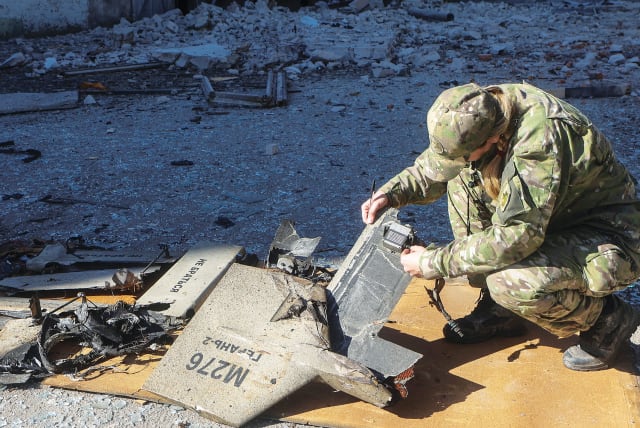Cheap Russian drone a menace to Ukrainian troops and equipment

Ukrainian soldiers are reporting that Russia is ramping up the frequency with which it uses suicide drones in combat. The drones are causing Ukraine to take a financial hit in destroyed equipment.
As Russia's invasion enters its 17th month, Ukrainian forces say Moscow is ramping up its use of low-cost suicide drones that are capable of destroying equipment many times their value and not easy to defend against.
The Lancet drone, an angular gray tube with two sets of four wings, has been an increasing threat on Ukraine's frontlines in recent months, according to Ukrainian soldiers.
Videos posted by pro-Russian social media channels over the last month appear to show Lancet drones damaging or destroying Ukraine's valuable Western-donated equipment, such as a Leopard 2 tank and a Caesar self-propelled howitzer.
Ukrainian servicemen from four different artillery crews named Lancets as one of the main threats they faced on the battlefield in conversations with Reuters.
Several soldiers said the frequency of its use had increased in recent months.
"Earlier, in spring, they were not using Lancets as often as they are now," 35-year-old artillery gunner Bohdan, who gave his call sign as Doc, told Reuters near Avdiivka on the Donetsk region frontlines.
Russia's defense ministry has been encouraging an increase of production of the Lancet as a cheap way to hit high-value Western equipment given to Ukraine for its counteroffensive, said Samuel Bendett, Adjunct Senior Fellow at the Center for a New American Security.
Bendett said that, according to publicly available Russian sources, a Lancet drone costs approximately 3 million roubles (around $35,000).
In comparison, analysts estimate a single S-300 missile used by Russia to cost at least several hundred thousand dollars. A Leopard 2 tank is worth several million dollars.
Because the Lancet is a single-use device that destroys itself on impact, Bendett said it can only be viable if the cost is kept down to the tens of thousands of dollars per drone.
Drone wars
Ukraine has also developed strong capabilities in drones - also known as UAVs (unmanned aerial vehicles) - as a cost-effective way to hit Russian targets.
Assault drones can send payloads to hit their target or serve as single-use "loitering munitions" - where they are strapped with explosives and ram the target themselves.
Bendett said there was unhappiness among pro-war Russian commentators about the large amount of Ukrainian videos showing successful UAV strikes, and that the Russian defense sector now wanted to create a competing narrative.
Russia appears to be copying some of Ukraine's earlier tactics, such as luring high-value targets forward into more exposed positions before hitting them with loitering munitions, Bendett said.
Yuriy Sak, an adviser to Ukraine's defense minister, acknowledged that Russia's increasing use of Lancets created difficulties.
"Every day we shoot down at least one or two of these Lancets ... but it's not a 100% interception rate unfortunately," he said.
Sak said the Lancet carried a relatively small explosive payload, ranging from 1.5-5 kg.
However, despite being less powerful than an artillery shell or most rockets, the Lancet appears to be able to inflict significant damage.
Lancet drones are flown in real-time by a pilot.
Sak said this distinguishes it from the Iran-made Shahed-136 drone, which Russia has also used extensively to hit Ukrainian targets, because a Shahed flies to a pre-programmed destination and cannot be piloted while in the air.
A near miss
The newest Lancet model, the Lancet 3, can fly up to 50 km (30 miles), Bendett said, making it better able to strike targets deep behind Ukrainian lines than any other Russian suicide drone besides the Shahed.
Its ability to loiter and then chase down its target makes it a threat to high-value equipment such as tanks, self-propelled artillery and rocket launch systems.
One of the Ukrainian vehicles most at risk is the BM-21 Grad, a large Soviet-era truck-mounted launcher that can fire a barrage of up to 40 rockets over a wide area.
Its firepower makes it a priority target for Lancet drones, and a video shared by pro-war Russian social media channels last week appeared to show a Grad being hit by a Lancet. Reuters could not independently verify the footage.
A crew member of a Grad launcher near Avdiivka, who introduced himself by his call sign Voron, recounted having a close brush with a Lancet which had been sent to attack his launcher in early May.
Having fired on a Russian target, Voron said his Grad was immediately targeted by a Russian S-300 missile, which missed by about 150 meters. However, a Lancet drone then appeared in the sky and chased the Ukrainian rocket system.
"We decided to flee ... After about 50 meters it fell just to my right. It didn't hit us, thank God," the 27-year-old said.
Drones like the Lancet, which fly low and slow, tend to confuse traditional air defense systems, which are built to intercept fast-moving targets with a larger heat signature.
Nets or metal cages can help limit the damage, said Sak, the defense ministry official, but the best defenses are radar-equipped automated anti-drone guns, as well as electronic warfare systems.
Sak said Ukraine needed many more of these systems from its allies.
Without such systems, Ukrainian soldiers are often forced to try to shoot the Lancets down with small arms.
"It's flying at 100 kilometers per hour, so shooting it down with small arms is not an easy challenge," said Sak.
Jerusalem Post Store
`; document.getElementById("linkPremium").innerHTML = cont; var divWithLink = document.getElementById("premium-link"); if (divWithLink !== null && divWithLink !== 'undefined') { divWithLink.style.border = "solid 1px #cb0f3e"; divWithLink.style.textAlign = "center"; divWithLink.style.marginBottom = "15px"; divWithLink.style.marginTop = "15px"; divWithLink.style.width = "100%"; divWithLink.style.backgroundColor = "#122952"; divWithLink.style.color = "#ffffff"; divWithLink.style.lineHeight = "1.5"; } } (function (v, i) { });

